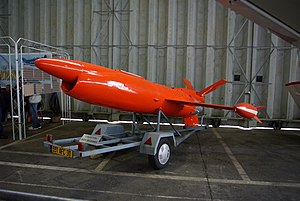

| CT20 | |
|---|---|

| |
| A CT20 restored by the Musée des ailes anciennes in Toulouse, France | |
| Role | Unmanned drone
Type of aircraft
|
| Manufacturer | Nord Aviation |
| Introduction | 1957 |
The Nord Aviation CT20 was a French turbojet-powered radio-controlled target drone introduced in 1957. Developed from the Arsenal / S.F.E.C.M.A.S. T.5.510, the CT.20 was built by Nord Aviation and powered by a Turbomeca Marboré II engine, providing a top speed of 900 km/h (560 mph; 490 kn) and a flying time of 55 to 60 minutes. It has been noted for its similarity to the Ryan Firebee. The unmanned drone was used in the development of air-to-air missiles following the Second World War.[1]
After the startup of the turbojet, the target drone is placed on a ramp and launched using two rockets. During its flight, the drone is controlled via radio signals from the ground. As it is made of light material, it is buoyant in water and can be recovered if it is forced to land on water.[2]

Data from Jane's All The World's Aircraft 1976–77,[4] Aviation Week & Space Technology : CT-20 Target Drone Main Characteristics[5]
General characteristics
Performance
|
| |||||||||||||||||||
|---|---|---|---|---|---|---|---|---|---|---|---|---|---|---|---|---|---|---|---|
| Manufacturer designations |
| ||||||||||||||||||
| By role |
| ||||||||||||||||||